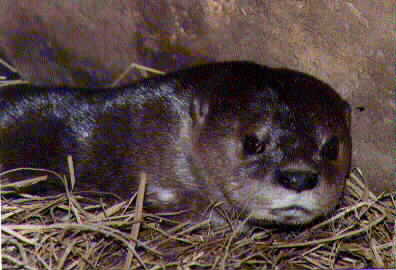Otters
Tadpole is an African Spotted Throat Otter.
There are seven genera of otters and 13 species. Of these there are three species
of clawless otters that search through the mud with their paws for their food;
one species of giant otter that can get up to 4.5 feet in head-body length with
a three-foot tail; and one species of sea otter. All inhabit fresh water areas
except the sea otter. There are eight species of river otters, and I will concentrate
on two species: The North American river otter also called the Canadian otter,
Lutra canadensis and the African spotted-throat otter, Lutra maculicollis. Much
of the information is the same for both species.
Otters are animals that spend the major portion of their waking hours in the
water. All river otters live near streams or other fresh water sources. They
are from 18 to 32 inches long from head to base of tail, with a tail from 12
to 18 inches long. They weigh from 7 to 32 lb. The males are usually larger
than the females in all species. The tail is thick at the base tapering to a
point. The head and neck are the same diameter. They have short legs with webbed
feet. Their ears are small and they are able to close both ears and nostrils
at will. Their fur is very short and extremely dense. It is dark brown and often
lighter underneath. The African spotted-throat otter (often called spot-neck
otter) has irregular white spots that are co-joined which can be under the jaw,
neck chest and abdomen area.
Otters are very playful animals and this is a major portion of their daily life.
They eat most water creatures including fish, frogs, crustaceans, mollusks,
etc. They will also eat land mammals and birds.
Mating and gestation depend on species and geographical location. They are polyestrus
(cycle several times a year) with a mean gestation of about 63 days. Litters
are from 1 to 5 which area weaned at 12 to 16 weeks. The baby otters begin to
swim at 8 weeks of age. They are long-lived and can attain over 20 years of
age.
Tadpole's coat is sleek and shiney and he
eats chicken and fish every day.
In Captivity
Otters must be provided with a water source for swimming.
Since they may drag food into it or use it as a potty area, it must be cleaned
often. Babies must be hand-raised to have them gentle enough for interaction.
Otters, as playful as they may seem can be extremely aggressive when not hand-raised.
The diet should consist of meat, fish, and vitamins. We grind chicken, including
bones, horse meat, and mix with ground fish, cat chow, vitamins and minerals and
water. We mix a large batch and freeze it in individual portions. Otters are very
intelligent and can learn with positive motivation training. We furnish a complete
diet and care instructions with all of our animals.
R-Zu-2-U Home
R-Zu-2-U FAQs
R-Zu-2-U Animal "Terms"
Treasure Ranch Home


